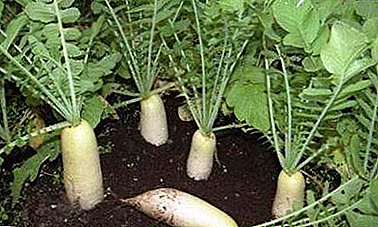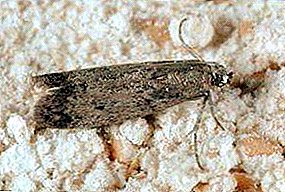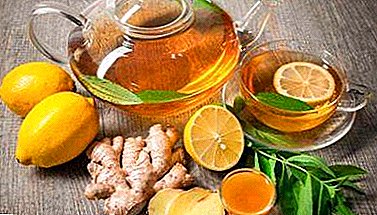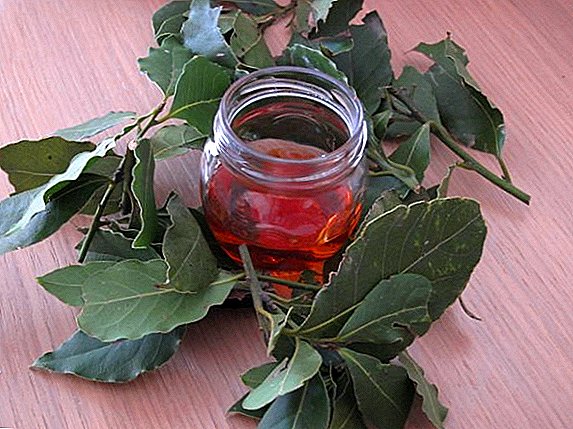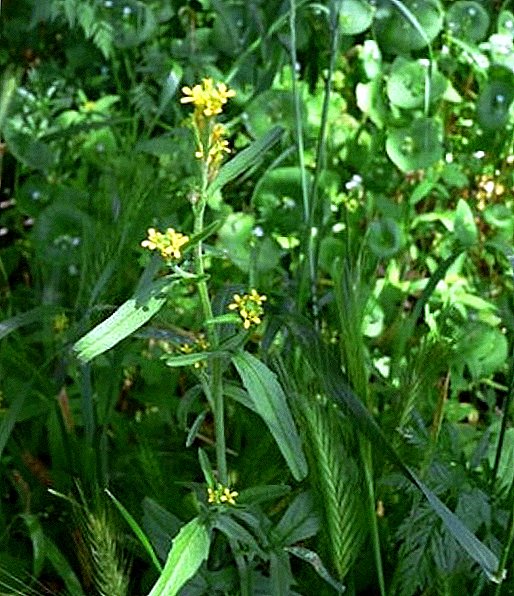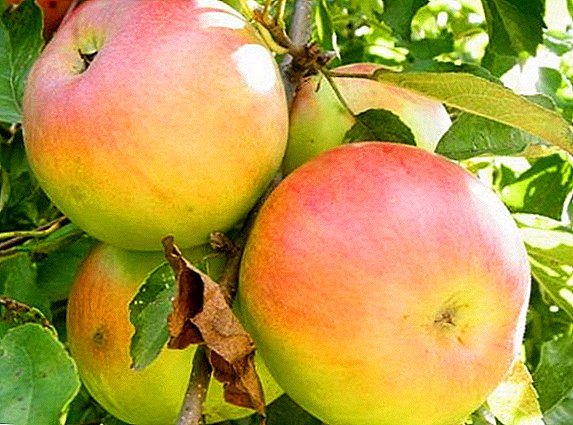 Due to the genetic characteristics and biological characteristics of apple trees, the Imrus variety is leading in the list of winter species. Their recognition among gardeners of the post-Soviet territory they received for stable fruiting, ripening, endurance under adverse conditions, resistance to diseases and pests. The harvest from one seven-year-old apple tree is more than enough for the needs of the family, but for commercial purposes you will need to plant several more seedlings. How to translate into reality the dream of an effective self-sustaining orchard in the yard, we will tell later in the article.
Due to the genetic characteristics and biological characteristics of apple trees, the Imrus variety is leading in the list of winter species. Their recognition among gardeners of the post-Soviet territory they received for stable fruiting, ripening, endurance under adverse conditions, resistance to diseases and pests. The harvest from one seven-year-old apple tree is more than enough for the needs of the family, but for commercial purposes you will need to plant several more seedlings. How to translate into reality the dream of an effective self-sustaining orchard in the yard, we will tell later in the article.
Inference history
Every gardener would like to acquire a hardy fruitful apple tree with demanded tasty fruits. For decades, these dreams have been tried by the leading specialists of the All-Russian Institute for Breeding with Fruit Crops.  The result of a long hard work was the elite variety "Imrus". It was obtained in 1977 when crossing the "Antonovka ordinary" and the standard hybrid of winter selection.
The result of a long hard work was the elite variety "Imrus". It was obtained in 1977 when crossing the "Antonovka ordinary" and the standard hybrid of winter selection.
Important! In order for the apple tree to give more yield, small loads are tied to the main shoots of young saplings, thus forming the angle between the trunk and the branch. It is believed that the larger it is, the more fertile the tree is.
Botanists set a goal to create a frost-resistant apple tree with high immunity and abundant annual yield. It was possible to achieve these qualities from Imrus only after many years of testing and improvement.
Check out such varieties of apple trees as "Medunitsa", "Bogatyr", "Spartan", "Candy", "Lobo", "Zhigulevskoe", "Mantet", "Dream", "Northern Sinap", "Sinap Orlovsky", " Currency "," Melba ".Already in 1988, the variety was enrolled in an elite selection group, and 7 years after that, it successfully proved its viability at a state inspection and was entered into the State Register.

Characteristic variety
A feature of Apple trees "Imrus" is the abundant intensive fruiting, endurance, high taste qualities and attractive presentation of fruits, as evidenced by their description and photo.
Did you know? The fourth part of an apple is air, which reveals the secret of a fruit not sinking in water.
Tree description
A characteristic feature of the hybrid is a medium thickened sprawling round crown and flaky brown-green bark on the trunk. The main branches are distant from each other and directed upwards, they depart from the trunk at an acute angle and can be strongly arched.
In the garden, the apple tree "Imrus" stands out rather the width than the height of the tree. The barrel does not develop above 4-5 m. The branches are thin, but elastic. The buds on them are tapered, of small size, densely covered with felt pile.  The leaves have the shape of an oblong oval with jagged edges and a specific helical tip. On top of the foliage is smooth and shiny, numerous streaks make it wrinkled. Petioles anthocyanin shade densely pubescent, thick and long.
The leaves have the shape of an oblong oval with jagged edges and a specific helical tip. On top of the foliage is smooth and shiny, numerous streaks make it wrinkled. Petioles anthocyanin shade densely pubescent, thick and long.
The bark on all parts of the tree is the same color. Inflorescences "Imrus" medium size, appear both on kolchatkah and fruit shoots in the first decade of May. White flowers with gentle scarlet tint collected in brushes of 5-6 pieces. Fruiting begins with the age of three seedlings.
Did you know? Apple trees live half a century, and they begin to bear fruit from the age of five to seven. Standard copies after the fifteenth years become fruitless, but continue to grow.
Fruit Description
There are many positive reviews about apple trees of the Imrus variety: consumers are satisfied not only with the genetic characteristics of the tree, but also with the quality of its fragrant fruits. In particular, there is a high precocity of the hybrid and abundant yield. Young four-year-old saplings are already capable of annually bringing from 5 to 22 kilograms of delicious fruits.  Externally, the apples are slightly ribbed, ovoid and small. The weight of one fruit varies from 150 to 200 g. During the period of removal from the tree, they are of a rich green color, and during consumer maturity they are filled with bright yellow.
Externally, the apples are slightly ribbed, ovoid and small. The weight of one fruit varies from 150 to 200 g. During the period of removal from the tree, they are of a rich green color, and during consumer maturity they are filled with bright yellow.
The skin is very thin, glossy, without the waxy coating typical of winter varieties. On the light surface, fine subcutaneous specks are clearly visible. The flesh of “Imrus” is creamy, fine-grained and juicy. Taste is gentle, sweet. The chemical composition of fruits is dominated by sugar, pectins, vitamin C and dietary fiber.
Important! In the cellar, boxes of apples should be placed away from other vegetables and fruits. This is due to ethylene released by them, which accelerates the maturation of plant fibers. As a result, an unfortunate neighborhood affects potatoes sprouted in the middle of winter and the aging of apple pulp.For tastes, tasters rated the grade at 4.4 points, and the appearance at 4.3 points out of 5 possible.

Pollination
The variety is partially self-pollinating. Breeders have made efforts to ensure the viability of pollen "Imrus" remained at the level of 30-55%. This means that in conditions of free pollination only 10–20% of greenfinches will form on the tree.
Therefore, in the neighborhood for him desirable apple trees of late ripening. Scientists are still exploring the best pollinators of the variety.
Gestation period
Harvest from an elite variety is possible in the second decade of September, but it is not mature enough for consumption.
Therefore, apples are very careful, for fear of mechanical damage and falls, which are detrimental to thin peels, are torn off and put into prepared disinfected storage boxes in the cellar. Some housewives wipe each fruit moistened in a weak solution of potassium permanganate with a napkin.  This nuance does not affect the taste of the fruit, but allows them to be stored until May. Especially on the "Imrus" there is no plaque that would protect it from the penetration of microbes.
This nuance does not affect the taste of the fruit, but allows them to be stored until May. Especially on the "Imrus" there is no plaque that would protect it from the penetration of microbes.
Under favorable storage conditions, apples reach consumer ripeness in a few months, this process lasts until spring. Mature fruit can be distinguished by a bright yellow color.
Important! Apple trees do not develop well in acidic soils. Adjust the pH of the need to liming, which is repeated every 3-4 years. It is also important not to use soil-oxidizing materials for mulch: wood, sawdust, needles of coniferous crops.
Yield
It is characteristic that the first fruiting is distinguished by a small number of apples, but it increases every year. For example, from the three-year-old "Imrus" breeders collected about a dozen fruits, and in the second year he already brought 9 kg. Up to eight years old seedling his yield reached 26 kg.  Specialists are often compared with the "Imrus" progenitor "Antonovka." Their fruiting is fundamentally different: if during mass cultivation mature apple trees of the first grade yield 226 centners per hectare each year, then in the second variant this figure barely reaches 90 centners per hectare
Specialists are often compared with the "Imrus" progenitor "Antonovka." Their fruiting is fundamentally different: if during mass cultivation mature apple trees of the first grade yield 226 centners per hectare each year, then in the second variant this figure barely reaches 90 centners per hectare
Transportability
The hybrid does not require greenhouse conditions, but this feature is offset by the need for the careful collection and transportation of fruits. The fact is that the only minus of the variety is too thin peel.
Some consumers speak positively about this, explaining their position as an opportunity to chew freely and enjoy the taste of tender pulp. Others, on the contrary, complain that a thin-skinned fruit is easily damaged during transportation.
Did you know? In the world ranking of apple growers, the primacy went to the People's Republic of China, the United States of America took the second place, and the third place went to Poland, which, by the way, leads Europe in terms of the number of exports of these fruits.
Winter hardiness
When breeding a variety, all testing, cultivation and hybridization of the new sprout took place in harsh climatic conditions, therefore Imrus is not afraid of frost, rain and cold.  Hybrid has the highest degree of winter hardiness.
Hybrid has the highest degree of winter hardiness.
Disease and Pest Resistance
The pride of scientists is the grafted Vf gene, which guarantees the absolute protection of the tree from scab and other diseases typical of apple trees. This nuance greatly facilitates the care of apples, because they do not need a preventive spraying.
It will be useful for you to learn more about the main pests of apple trees.
Application
Another positive characteristic of the variety is the versatility of its fruits. Apples "Imrus" often harvested for consumption raw in the winter. After ripening, they can also be used for all sorts of homemade preparations, drying, filling for pies, freshly squeezed juice.
Tips for buying healthy seedlings
Before you choose apple seedlings, you need to carefully examine the root system, stem and skeletal branches.  Its roots should be strong, uniform, whole and smooth. Look for molds, putrid areas, galls or any nodules.
Its roots should be strong, uniform, whole and smooth. Look for molds, putrid areas, galls or any nodules.
Check out their freshness. To do this, just scratch your fingernail slightly at the end of one of the processes. Fresh wood at the wound site is clear evidence of quality planting material.
Important! When sprinkling mulch in apple tree trunks, always move 15 centimeters from the tree. This is necessary in order to protect the trunk and root system from pathogenic microorganisms that arise in the process of decomposition of the material used.Choose copies with a holistic surface of the trunk. If we are talking about grafted seedlings, carefully examine the place of vaccination. It should be without cracks and breaks.
Experts believe that the ideal parameters for apple seedlings is a powerful root system, an even and viable trunk about one and a half meters in height with 4-5 skeletal branches and a healthy root neck. 
Planting apple seedlings
Buying a healthy seedling is only half the success in the cultivation of the "Imrus". The remaining 50% depends on the site that you chose under the apple tree, the timing of planting and the rooting process itself.
Learn more about planting apple seedlings in the fall.
Optimal timing
In a temperate climate zone, apple trees are often planned for autumn or springtime. The main thing is that the earth was warm enough, and the daytime temperature fluctuated within + 12-14 ° С.
In the case of spring rooting, be prepared for the need to constantly moisten the forest hole before the cold weather - this will save the tree from drying out. Immediately before planting, you need to soak the rhizomes in a tank with water for a day, and after lowering it in a hole, water it until the soil absorbs moisture. All work is best done in late April or early May.
In the fall, apple trees are best planted a few weeks before the cold snap. In our latitudes, this period often falls in the first two decades of October. With such rooting trees are not at risk to dry out, as in the previous case. Given the winter hardiness of the Imrus variety, it can be rooted in the fall.
Did you know? On average, an apple is only 80 kilocalories.
Choosing a place
Apple trees love enriched chernozem soils with neutral acidity, so the oxidized area will need to initially be treated with a well-known fuzz or dolomite flour.
The amount of substance applied depends on the pH reaction. At home, you can check it with table vinegar - just drop a few drops on a handful of earth. The absence of hissing and small bubbles indicates an acidic environment. It is also important for these fruit trees that the terrain be protected from northern winds and drafts. Avoid when choosing a site of stony, marshy places, lowlands, where cold air masses always settle, and the sun.
Apple trees will be provided with the full development of a well-lit zone, where groundwater is located no closer than 2 meters to the surface of the earth. If the tree is in the shade, its shoots will stretch greatly, and the fruiting will decrease.
Stepwise landing process
Planting apple seedlings is preceded by a long process of preparation. It includes not only the selection of the site, but also the preparation of the soil, the excavation of the corresponding pit and the creation of conditions for the formation of useful microflora in it.  At a certain site it is necessary to make a recess of 70 cm, 1 m in diameter. At the same time, lay the top layer of soil in a separate pile, later it will be useful for you to prepare a nutrient mixture.
At a certain site it is necessary to make a recess of 70 cm, 1 m in diameter. At the same time, lay the top layer of soil in a separate pile, later it will be useful for you to prepare a nutrient mixture.
Then lay out the bottom of the expanded clay, on top, pour the prepared substrate of equal parts of peat, humus, compost and deposited land. When all of the above manipulations have been carried out, the pit should be covered with a film, securing the edges.
Did you know? Botanists claim that an apple tree is every second tree on our planet: it is the most common fruit crop in the world.Begin planting should re-inspect the planting material and check the freshness of the roots. After removing all the dead parts, dip the roots in a clay mash.
 Now you can open a prepared pit and place a seedling in it. Do not forget to straighten the roots.
Now you can open a prepared pit and place a seedling in it. Do not forget to straighten the roots.Water the tree and sprinkle with a layer of fertile soil. To fill the voids formed in the roots, shake the stem well and tamp the substrate again.
Do not bury the passage of the trunk in the rhizome - it should rise by 4-5 cm. From above you can pour a small mound of earth on it, which will ensure the outflow of water during precipitation and watering.
Seasonal care features
After planting a garden it is important for him to provide comprehensive care. Apple trees of the Imrus variety are completely non-demanding and easily adaptable to any cultivation conditions. Elementary seasonal care includes watering, fertilizing, pruning and treating the soil. 
Soil care
Full vegetation of the tree is possible under conditions of free access of oxygen to the roots, moderate soil moisture and the absence of weedy crops that pull nutrients from the depths and contribute to the reproduction of harmful insects and microorganisms.
Important! For massive plantings of apple trees of the "Imrus" variety, keep a distance of 2-3 meters between neighboring plants.Implement this recommendation into reality should be immediately after planting the seedling. The final stage should be mulching pristvolnyh circles. Mulch will create obstacles for the rapid evaporation of water and will not allow the development of weeds.
Regularly monitor the condition of pristvolny circles, periodically loosen the substrate in them and update the mulch as necessary.  Of particular importance for the "Imrus" has the amount of moisture. Experienced gardeners advise to focus on the status of pristvolny holes of young trees and moisten them to the best of drying the upper layer.
Of particular importance for the "Imrus" has the amount of moisture. Experienced gardeners advise to focus on the status of pristvolny holes of young trees and moisten them to the best of drying the upper layer.
Also, when watering it is important to take into account the age of the apple trees. For example, for annual specimens you will need to pour out 2-3 buckets of water per square meter of the trunk circle. Two-year old enough for 4-5 buckets. Trees under 5 years old will be enough for 7-8 buckets, and those that are older are 9-10 buckets.
The first moistening to young trees is organized in the spring until the buds open, and then repeated every 14–20 days, depending on weather conditions. Older apple trees need the next watering only after budding and during the formation of greenfinches.
Important! After harvesting the fruit and during it is not worth watering the apple trees. For them, it is fraught with strong growth. Young sprouts will not have time to get stronger before winter and are likely to die. With severe frostbite, the tree will suffer greatly.In the hot summer, so that the ovary does not crumble prematurely, watering must be repeated when the fruit grows. 14 days before harvesting, the last moistening of tree trunks is planned. Sometimes with dry and warm September, you may need additional watering, which will help the tree to winter.

Fertilization
The first feeding of the apple orchard is carried out in the spring, at the beginning of the active growing season. During this period, trees need nitrogen-containing substances that will help them quickly build up their green mass.
For this purpose, an over-ripe mullein, an infusion of chicken manure or a mixture of nitroammofoski and ammonium nitrate (1 tablespoon) will do.
During the formation of the ovary, fertilizer is used from 150 g of superphosphate, 40 g of potassium chloride, 10 g of ammonium nitrate, compost buckets, and 30 g of nitroammophos. In the second decade of August, the branches on the apple tree stop growing. During this period, it is necessary to make autumn mineral complex fertilizers or humus.
To improve the frost resistance, superphosphate feeds are also desirable. The working solution is prepared at the rate of 50 g of substance per 1 l of water.
Did you know? To prepare a glass of apple cider, you need 36 apples.
Preventive treatment
The best prevention for "Imrus" is competent agrotechnology of cultivation. The tree has a unique immunity from diseases and pests, therefore it does not need chemical disinfection.
If you do not provoke the appearance of fungal mycelium and pathogenic microbes by improper moistening and dressing, the tree will not get sick.  Therefore, in time to clean the garden the fallen leaves, monitor the condition of the soil, remove weeds, loosen and mulch pristvolny circles.
Therefore, in time to clean the garden the fallen leaves, monitor the condition of the soil, remove weeds, loosen and mulch pristvolny circles.
In the spring for safety, you can spray the crown pepper or mustard tincture.
Pruning
The main objective of the annual cutting of the branches on the apple is the elimination of old, sick and damaged parts.This is done for the proper circulation of juice. In addition, the procedure stimulates the tree to fruiting.
Considering the spread of the tall crown "Imrus", do not forget about the removal of the directed inside, creating a shadow, competing among themselves shoots (leave the strongest). When cutting, always leave 3-4 eyes. Often, apple trees require 2 haircuts per year: in the spring, everything is dry and unnecessary, and in the fall - unpromising and weak. The last pruning should be planned when all the foliage falls and the juice movement stops. The first one falls on the beginning of March.
After the forging trim, the lower tier of the crown should consist of a three-year increment, and the entire crown should be uniformly illuminated. You need to leave only those one-year shoots, whose length is 30 cm, and the top ends with inflorescence.
All about the correct pruning of apple trees in spring and autumn.Remember that the core of the crown also requires regular rejuvenation. Therefore, be sure to clean it from the gnarled, heavily thickened shoots. When cutting, always leave small knots that will soon give new shoots.
Big slices must be treated with garden pitch. 
Preparing for the winter
Winter-hardy varieties in the early stages of life need help to winter. To do this, the above-ground part of young seedlings experienced owners cover with burlap or other thick cloth. The soil in pristvolnyh circles is covered with a thick layer of humus.
Some are sprinkled on top of it with fresh soil, only you need to take it outside the garden, so that when digging it does not expose the rhizomes of other plants.
From rodents, tree trunks are hidden under a half-meter-thick sheet of roofing felts, or they cost by pine branches.
Did you know? The oldest apple tree is 370 years old: it grows in Manhattan and, oddly enough, continues to bear fruit.Mature trees will not need such shelters, as they have enough resources to withstand the harsh winter. Gardeners joke among themselves that “Imrus” is bred specifically for lazy fruit businessmen, because this variety will allow without any special effort to get a good profit from your garden.



